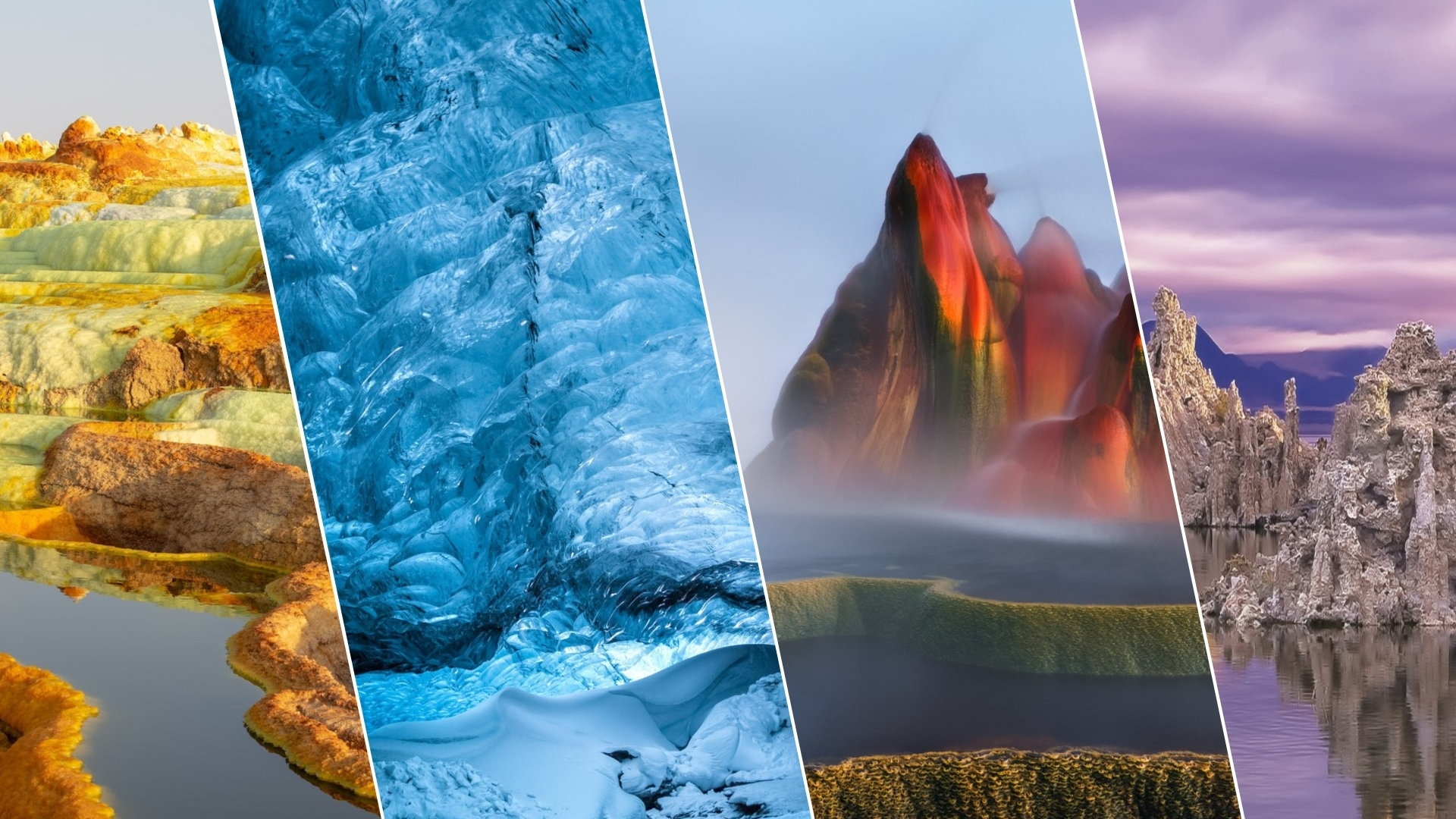Some places on Earth don’t seem real.
They defy geography, logic, even time — like dreams carved into the landscape.
This is a journey through ten surreal destinations that make you question whether you’re still on the same planet.

1. The Door to Hell — Turkmenistan
Deep in the Karakum Desert burns a fire that has never gone out.
Locals call it “The Door to Hell.”
In 1971, Soviet engineers were drilling for gas when the ground collapsed, opening a vast crater. To prevent the spread of methane, they set it on fire — expecting it to burn for a few days.
It’s been burning ever since.
At night, the desert glows like a furnace. The air shimmers, and a faint hum rises from the flames. It’s terrifying, magnetic, hypnotic — a vision of the Earth’s hidden power.
Standing there, you realize: this planet isn’t just alive — it’s breathing fire.
2. Salar de Uyuni — Bolivia
After the rain, Salar de Uyuni becomes the world’s largest mirror.
You stand in the middle of the Bolivian salt flat, and the sky doubles itself beneath your feet — clouds above, clouds below, infinity all around.
There’s no horizon. No up, no down. Only reflection.
Photographers call it “Heaven’s Floor.”
Travelers call it the Edge of Reality.
When night falls, the stars multiply — and suddenly you’re walking in space, every step echoing through eternity.
3. Zhangjiajie National Forest — China
If you’ve seen the movie Avatar, you already know this landscape — because it inspired it.
Zhangjiajie, in the Hunan province of China, is home to sandstone pillars that rise like floating islands, some over 1,000 meters high. Mist weaves through them like silk.
The locals once called it “the land where gods descended.”
You understand why.
Riding the glass elevator of Bailong, you ascend through clouds until the ground disappears. What’s left is silence, birds, and the surreal illusion that you’re walking among giants.
It’s not a forest. It’s a dream sculpted by wind and time.
4. Lake Natron — Tanzania
Welcome to Lake Natron, the crimson mirror of Africa.
Its waters are so alkaline that they can turn animals into stone — literally preserving them in a chalky shell of minerals.
The red color comes from microorganisms that thrive in extreme salinity.
It’s beautiful — and deadly.
Flamingos come here to nest, safe from predators who dare not cross the toxic shallows. As the sun sets, the lake glows like blood, reflecting the mountains in eerie stillness.
A place of death, yes. But also of fierce, untamed life.
5. Waitomo Glowworm Caves — New Zealand
Imagine floating silently through a dark cave — and above you, thousands of tiny stars begin to glow.
This isn’t a dream. It’s Waitomo, home to the bioluminescent glowworms of New Zealand.
Their lights shimmer on the cave ceiling, forming constellations that shift and pulse. The underground river reflects them perfectly, turning darkness into a galaxy.
The silence is sacred. The only sound is the drip of water — and your own heartbeat slowing to match the rhythm of the cave.
You realize you’re not under the stars — you’re inside them.
6. Cappadocia — Turkey
A desert of fairy chimneys and ancient secrets.
Cappadocia looks like it was drawn by a dreamer.
Eroded rock spires rise from the earth, and beneath them lie entire underground cities carved thousands of years ago.
At dawn, the sky fills with hot-air balloons — hundreds of them — painting the horizon with color.
The land glows gold. The air hums with quiet awe.
It feels like stepping into a fairy tale — one written in stone and firelight.
7. The Marble Caves — Chile
On the remote shores of Patagonia, water has spent thousands of years sculpting marble into swirling cathedrals.
Cuevas de Mármol, or the Marble Caves, are perhaps the most delicate masterpiece on Earth.
As you drift by boat through turquoise water, sunlight dances across the walls — blue melting into white, white melting into silver. The patterns seem alive, like liquid art.
Every corner looks different depending on the hour, the season, the mood of the lake.
It’s not a place you simply see.
It’s a place that teaches you to look differently.
8. Socotra Island — Yemen
Socotra doesn’t look like Earth.
It’s often called “the alien island.”
Located in the Arabian Sea, it’s home to strange plants found nowhere else — including the Dragon’s Blood Tree, whose umbrella-shaped crown looks like something out of a sci-fi movie.
The air smells faintly of resin and salt. The landscapes feel ancient, untouched by civilization.
When the wind blows through the valleys, the branches creak like whispers of forgotten time.
Socotra isn’t just rare — it’s otherworldly.
A reminder that life, when left alone, becomes wildly creative.
9. The Ice Caves of Vatnajökull — Iceland
Beneath Europe’s largest glacier, a hidden world of crystal and blue awaits.
Every winter, explorers venture inside the Vatnajökull Ice Caves, where walls of ice shimmer like glass. Light filters through in soft waves — turquoise, sapphire, aquamarine — an ocean frozen mid-motion.
It’s as if time itself has stopped breathing.
The air is so still that even your footsteps feel intrusive.
You touch the walls, and it feels like touching eternity — fragile and pure.
In a world warming too quickly, these caves are both a wonder and a warning.
10. The Wave — Arizona, USA
Nature’s art gallery — carved not by hands, but by wind.
Hidden within the Coyote Buttes of Arizona, The Wave is a swirl of orange sandstone that looks like a frozen ocean.
The patterns ripple like sound waves, as if the Earth once sang and turned to stone mid-note.
Only a handful of visitors are allowed each day to protect its fragile surface. Walking through it feels sacred — like trespassing in a cathedral built by time.
It’s proof that beauty doesn’t need perfection.
It needs patience.